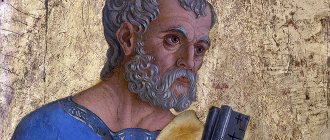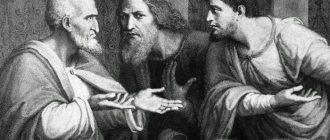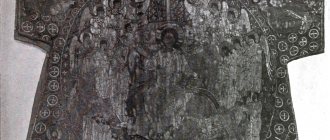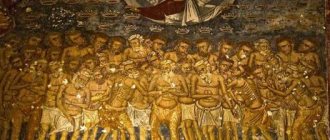Moscow Apostle (1564) Apostle, printed by Ivan Fedorov in 1574 in Lvov.
the oldest surviving book that was printed on the territory of what is now Ukraine. This term has other meanings, see Apostle (meanings).
"Apostle"
- a liturgical book containing: parts of the New Testament - “Acts” and “Epistle of the Holy Apostles”, - a collection of general and Sunday prokeimns, prokeimns for special services (dedicated to martyrs, prophets, etc.) and alleluia - individual verses from the Psalter or other books of Holy Scripture. The book has special markings for “conceptions” - fragments for reading during various services. Basically, the conceptions of the Apostle are preceded by the word-address “Brotherhood” (in personal letters - “Child Timothy”, “Child Philemon” and the like.)
During church services, the Apostolic Conceptions are proclaimed primarily by a special reader (usually dressed in a surplice), less often by a deacon; if two deacons participate in the service, the second one. At the same time, the priest has the opportunity, after blessing, to allow any lay parishioner, including a woman, to read the Apostle[1].
The Apostle is read at the Divine Liturgy of John Chrysostom and the Divine Liturgy of Basil the Great in the part called the Liturgy of the Catechumens, after the Trisagion, before the reading of the Gospel. The Apostle may be read at the Liturgy of the Presanctified Gifts[2] (in this case, however, the Apostle is not always read). It is read during the service of the Great Hours[3], during some prayers and services, during the performance of some Sacraments (Baptism, Wedding, Unction). It is extremely rare, but still there is a reading of the Apostle during matins (example: matins on Holy Saturday[4]) and even during vespers (example: vespers on Good Friday[5]). Before the reading of the Apostle, one or two prokeimnas are read, and after the reading the alleluia is performed three times.
History of creation[ | ]
By the 1550s, the need to publish printed books had become urgent in the Russian kingdom. Ivan the Terrible gives the order to set up a printing house. There were several reasons for this, including: the need for books in connection with the expansion of territory (the conquest of Kazan), the development of crafts and trade in general; “the need to strengthen state censorship”; “policy of centralization and unification of ideological influence”[1]. Ivan Fedorov, in the afterword to the “Apostle,” speaks of the need to correct the text of handwritten books, which were often distorted by scribes[2].
"The Apostle" was not the first book published in Moscow. Six so-called anonymous editions (three Gospels, two Psalters and the Triodion) were published in the 1550s, shortly before the first editions of Ivan Fedorov (the latest of them - perhaps soon after the publication of the Apostle)[3].
"Apostle" spread
The first set of laws in Rus'
Russian Truth" is the oldest code of laws created in the 11th-12th centuries. Its founder was Yaroslav the Wise. This set of laws helped regulate public life in the state and relationships between people through various fines and laws.
The first printed books, like the first laws, were created under the patronage of kings. Having appeared in the lives of ordinary people, they radically changed the entire structure, but each in their own way.
Edition characteristics[ | ]
“Apostle” is printed on French glued paper in a small sheet. The book contains 267 sheets (534 pages), each page has 25 lines. The first 6 sheets are without marks. Numbering is alphabetic Cyrillic, starting from the 7th sheet. The original format is not known exactly (all existing copies were trimmed by bookbinders), but it is approximately 28x18 cm (1:1.56). The proportions of the typesetting strip (1:1.72) also tend to the golden ratio[4].
For the first time in the Moscow edition an engraved frontispiece appears - the figure of the Evangelist Luke in the triumphal arch[5]. In addition to this engraving, the book contains 48 headpieces (from 20 boards), 22 initial letters (from 5 boards), 51 flower frames (from one board). The names of the sections are typed in script[6].
The engraving on the frontispiece is a composite one (separate boards were used for the arch and for the evangelist). Fedorov used the arch in other publications. It is known that it was based on an engraving by the artist E. Schön from the Bible, printed in Nuremberg in 1524 by Peipus. This practice was common in book printing, but in The Apostle the arch design is creatively reworked. The Evangelist Luke, depicted in reverse perspective, is completely original. The closest prototypes should be sought in Russian church frescoes. Most likely, the frame and the evangelist were made by different engravers. The author of the frame may be Ivan Fedorov himself[7].
Headpieces with foliate patterns are at the same time similar to traditional Russian handwritten headpieces, the Gothic ornament of German incunabula and the “Venetian” ornament of modern Western printed books. The Renaissance influence of the latter is especially noticeable in the ornamentation of Fedorov’s “Books of Hours,” published after the “Apostle”[8].
The Apostle font is executed much more carefully and accurately than the fonts of anonymous publications. The main and additional lines are of the same thickness. The font is based on a handwritten semi-charter from the 16th century[9].
Fedorov’s “Apostle” is a true masterpiece of the first printed Russian book. It surpasses both the early “anonymous editions” and subsequent editions by Fedorov himself in terms of artistic integrity, typographic accuracy, type design and accuracy of typesetting. In “Apostle”, for the first time in a Slavic book, the typesetting strip was turned off on both the left and right sides[5]. Words are separated by spacing, but not always.
The Books of Hours, printed by Fedorov and Mstislavets back in Moscow, are executed in a much more modest manner. Fedorov's foreign publications are very different both in type and design from Moscow ones. Fedorov uses a smaller font in them, set in two columns. Together with the frame from the Moscow “Apostle,” he uses a more modest engraving depicting King David[10].
Bench of the Feodorovsky Cathedral
DELIVERY METHODS
1. Pickup
Pickup of orders is FREE
daily from 11:00 to 19:00 from the clergy house at:
G. St. Petersburg, st. Mirgorodskaya, 1B.
2. Delivery throughout Russia to the point of delivery of orders (POI) by Boxberry delivery service
Delivery costs are calculated automatically in your personal account at the time of placing your order. Orders are shipped only after full payment for the order and delivery. The parcel storage period is 14 days.
After sending the order, a tracking number will be sent to the email specified when placing the order.
3. Courier delivery in Russia using Boxberry delivery service
Delivery costs are calculated automatically in your personal account at the time of placing your order. Orders are shipped only after full payment for the order and delivery.
After sending the order, a tracking number will be sent to the email specified when placing the order.
If the courier was unable to deliver the first time due to reasons beyond his control, a second attempt to deliver the item will be made, without charging an additional fee, after 1-3 days (depending on the size of the locality: faster in large cities). After this period, the order will be transferred back to the online store and cancelled.
4. Delivery throughout Russia to the point of delivery of orders (POI) by SDEK delivery service
Delivery costs are calculated automatically in your personal account at the time of placing your order. Orders are shipped only after full payment of the order and delivery
When placing an order, you select a convenient pick-up point for your orders. When an order is received at this pick-up point, you will receive an SMS message indicating the arrival of the order, indicating the address and opening hours of the office.
When receiving an order, you need to know the 10-digit shipment number (available in SMS) and have an identification document with you.
Free ORDER STORAGE TIME at the point of issue is 14 DAYS.
5. Courier delivery throughout Russia via SDEK delivery service
Delivery costs are calculated automatically in your personal account at the time of placing your order. Orders are shipped only after full payment for the order and delivery.
After sending the order, a tracking number will be sent to the email specified when placing the order.
Within two working days from the moment the order arrives in the recipient’s city, SDEK notifies you of the arrival of the order and agrees with you on the date and place of delivery.
The order is delivered by courier to your door on weekdays during business hours. On the day of delivery, the courier notifies you of his arrival by calling approximately an hour before arrival.
5. Delivery by Russian Post
The cost of delivery by Russian Post is calculated automatically on the website when placing an order. Delivery by ground and air transport is possible.
After sending the order, a tracking number will be sent to the email specified when placing the order.
6. International shipments
Delivery costs are calculated according to Russian Post tariffs after the order is fully assembled.
After sending the order, a tracking number will be sent to the email specified when placing the order.
7. Delivery throughout Russia to the point of delivery of orders (POI) by SDEK delivery service.
Delivery costs are calculated automatically in your personal account at the time of placing your order. Orders are shipped only after full payment for the order and delivery. The free storage period for parcels is 7 days.
After sending the order, a tracking number will be sent to the email specified when placing the order.
PAYMENT – 100% prepayment
For legal entities Bank transfer (non-cash payment). You can contact us by mail and discuss the method of payment and delivery. For individuals payment method: Bank cards. All payments are made through the Robokassa payment system. There is no commission!
Coronavirus:
· To protect recipients from the spread of coronavirus, the courier service is introducing the following measures:
· Every day, before setting out on routes, couriers undergo a mandatory examination for primary signs of colds and temperature measurement with a non-contact thermometer;
· Couriers use personal protective equipment - masks, disposable gloves, antiseptics;
· The office and warehouse for shipping couriers are treated daily with chlorine-containing agents, UV lamps are installed;
· At the request of the client or online store, the courier can leave a prepaid order at the door of the apartment or at the security guard of the recipient’s premises.
Printing Features[ | ]
When publishing the Apostle, Fedorov used two inventions characteristic of Russian book printing. Firstly, this is the principle of “crossing lines” (the term of E. L. Nemirovsky), already used in anonymous publications, when diacritics are typed in letters separate from the letters. Secondly, an original method of printing in two runs (of paint) from one plate, apparently invented by Fedorov himself. First, the letters that were to be printed in red (cinnabar) were raised above the surface of the form and an impression was made. They were then removed from the typesetting, after which the main text was printed onto the same sheets with black ink[11].
Notes[ | ]
- Collection “Ivan Fedorov the First Printer”, Leningrad, 1935, p. 56.
- “... the tsar... Ivan Vasilyevich... ordered the holy books... to be bought and placed in the holy churches:... But among them there were few that were suitable, while others were all spoiled by the scribes, ignorant and ignorant of the sciences, and some were spoiled due to the negligence of the scribes. This also reached the ears of the king; Then he began to think about how to organize the printing of books, like the Greeks, and in Venice, and in Italy, and among other nations, so that from now on the holy books would be published in a corrected form.” Afterword by Ivan Fedorov to the “Apostle” of 1564. Archived May 26, 2011.
- Sidorov A. A.
History of the design of Russian books. M., Leningrad, 1946. pp. 52-53. - Sidorov A. A.
History of the design of Russian books.
M., Leningrad, 1946. P. 64. See also: Nemirovsky E. L.
Big book about the book. M., 2010. P. 368. - ↑ 1 2 Sidorov A. A.
History of the design of Russian books. M., Leningrad, 1946. P. 54. - Nemirovsky E.L.
A larger book about the book. M., 2010. P. 369. See also: here. - Sidorov A. A.
History of the design of Russian books. M., Leningrad, 1946. pp. 56-59, 66. - Shchelkunov M.I.
History, technology, art of printing. M., Leningrad, 1926. P. 310. - Bulgakov F.I.
Illustrated history of book printing and typographic art. T. I. St. Petersburg, 1889. P. 220. - Sidorov A. A.
History of the design of Russian books. M., Leningrad, 1946. S. 55, 63, 67. - Nemirovsky E. L.
Invention of Johann Guttenberg. M., 2000. S. 166-167. - Nemirovsky E. L.
Big book about the book. M., 2010. P. 370. - "Apostle" to order. The book of pioneer printer Ivan Fedorov was stolen in Kyiv | Incidents | Arguments and Facts
- News / Patriarchy.ru
Assassination of Emperor Alexander II
Discussion: 6 comments
- liana:
05.10.2009 at 00:00everything was great, found a lot of new information
- Miyadina Nastya:
01/19/2010 at 00:00
Of course, very good material, but for a 6th grade student it is very difficult to understand
- Maria:
03/08/2010 at 00:00
Great, concise and in terms of historical events too (as it seemed to me, although I’m not a historian). Special thanks for the picture-episode!
- Ordinary Rusich:
10/26/2010 at 00:00
Long live the Motherland! The Fatherland is our everything. Glory of the Great Russian Empire!!
- Dimitri:
03/14/2012 at 00:00
As always, the article is concise, precise and very interesting. God bless. Very informative and broadens your horizons in relation to your own native national history.
- Nastasya:
10/29/2015 at 00:00
good history of the book!









